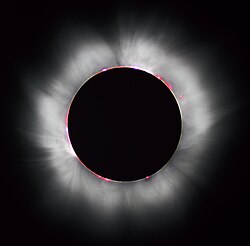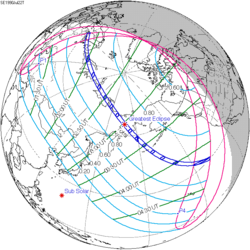| Total eclipse | |
 Total eclipse near Guadeloupe | |
| Gamma | 0.2391 |
|---|---|
| Magnitude | 1.0441 |
| Maximum eclipse | |
| Duration | 249 s (4 min 9 s) |
| Coordinates | 4°42′N82°42′W / 4.7°N 82.7°W |
| Max. width of band | 151 km (94 mi) |
| Times (UTC) | |
| Greatest eclipse | 17:29:27 |
| References | |
| Saros | 130 (51 of 73) |
| Catalog # (SE5000) | 9503 |
A total solar eclipse occurred at the Moon's descending node of orbit on Thursday, February 26, 1998, [1] with a magnitude of 1.0441. A solar eclipse occurs when the Moon passes between Earth and the Sun, thereby totally or partly obscuring the image of the Sun for a viewer on Earth. A total solar eclipse occurs when the Moon's apparent diameter is larger than the Sun's, blocking all direct sunlight, turning day into darkness. Totality occurs in a narrow path across Earth's surface, with the partial solar eclipse visible over a surrounding region thousands of kilometres wide. Occurring about 1.1 days before perigee (on February 27, 1998, at 19:50 UTC), the Moon's apparent diameter was larger. [2]
Contents
- Observations
- Eclipse timing
- Places experiencing total eclipse
- Places experiencing partial eclipse
- In popular culture
- Eclipse details
- Eclipse season
- Related eclipses
- Eclipses in 1998
- Metonic
- Tzolkinex
- Half-Saros
- Tritos
- Solar Saros 130
- Inex
- Triad
- Solar eclipses of 1997–2000
- Saros 130
- Metonic series
- Tritos series
- Inex series
- Notes
- References
- External links
- Sites and Photos
- Videos
Totality was visible in the Galápagos Islands, Panama, Colombia, the Paraguaná Peninsula in northwestern Venezuela, all of Aruba, most of Curaçao and the northwestern tip of Bonaire (belonging to Netherlands Antilles which dissolved later), all of Montserrat, Guadeloupe and Antigua and Barbuda. A partial eclipse was visible for parts of Mexico, the southern and eastern United States, Central America, the Caribbean, northern South America, West Africa, and the Iberian Peninsula.









































































































